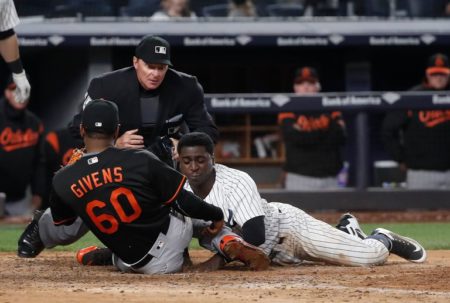Gregorius vs. Givens Proves Baseball Will Always Be a Contact Sport
 Everybody knows about Pete Rose running over Ray Fosse in the 1970 All-Star Game; and the 2011 collision where Scott Cousins took out Buster Posey and ended his season. Since home plate is the most contested part of a baseball diamond, changing the rules to prevent collisions between catchers and baserunners made a lot of sense. But it didn’t entirely end the problem, as Friday night’s game between the New York Yankees and the Baltimore Orioles made clear.
Everybody knows about Pete Rose running over Ray Fosse in the 1970 All-Star Game; and the 2011 collision where Scott Cousins took out Buster Posey and ended his season. Since home plate is the most contested part of a baseball diamond, changing the rules to prevent collisions between catchers and baserunners made a lot of sense. But it didn’t entirely end the problem, as Friday night’s game between the New York Yankees and the Baltimore Orioles made clear.
The game was tied in the bottom of the 11th inning and the Yankees’ Didi Gregorius was at third base with the potential winning run. When a pitch from Orioles reliever Mychal Givens got away from catcher Caleb Joseph, Gregorius took off for home and the Yankee faithful anticipated a joyous reaction to a walk-off win on a Friday night in the Bronx.
But fate had other ideas. Joseph corralled the ball and underhanded it to Givens, who caught the ball and effectively blocked the plate, preventing Gregorius from touching home plate. It’s about as GIF-worthy a play as you’re likely to see in a baseball game. The umpire correctly called Gregorius out, thus ending the inning and sending the game into the 12th.
But the Yankees challenged the umpire’s call. The possibility of the call being overturned – which would then hand the Yankees a win – hung in the air at Yankee Stadium. However, the call was upheld and the game went on. The Yankees lost when Pedro Alvarez hit a grand slam in the 14th inning to win it.
There are two rules at play concerning collisions at home plate, and Givens and Gregorius found their way into a gray area between them. Since this isn’t a legal brief, the wording of them won’t be analyzed too much. But it’s an interesting distinction that baseball made when putting these rules into place.
Rule 6.01(i)(1) regards the actions of a runner when trying to cross the plate. If the runner goes out of his way to make contact with a catcher – or, importantly, any other player covering home plate – the runner is called out. In other words, running over a player isn’t allowed. Gregorius slid headfirst into home (a bad idea for his own safety, but one he apparently got away with doing), so there was no going out of his way involved in this play.
But the companion rule, 6.01(i)(2) is worded differently. It says that a catcher cannot block the path of a runner trying to score if he does not have possession of the ball. But the catcher can block the plate, if he’s attempting to field a throw made to him. Unlike Rule 6.01(i)(1), this rule is limited to a catcher only, and did not apply to Givens as he was covering home plate.
The Yankees’ challenge – apart from being a brazen attempt to be awarded a win – displayed a misunderstanding of Rule 6.01(i)(2). Givens did indeed block the plate, but he was allowed to do so because he was trying to field the flip from the catcher. And only a catcher is prohibited by rule from blocking the plate.
It was a bang-bang play that showed how collisions at home plate are always going to happen, no matter what rule changes are made. And for Yankees fans who were disappointed at the result, at least you got to see Aaron Judge take a homer away from Joseph two innings later. That’s something, isn’t it?

























